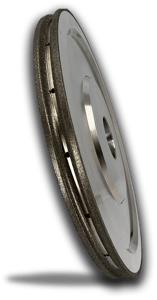Tips for Preventing Peeling of Electroplated Diamond and CBN Wheels
In the world of precision grinding, electroplated diamond wheels have become a cornerstone, especially in applications involving hard materials like ceramics, aerospace parts, and carbide. However, a common problem often encountered is the peeling off of the diamond coating. Let's explore why this happens and how to prevent it.
 Why Does an Electroplated Wheel Peel?
Why Does an Electroplated Wheel Peel?
One of the primary reasons for the peeling of an electroplated grinding wheel, especially those with electroplated diamond or CBN, is due to the improper cleaning of the wheel core. Before the application of the abrasive grains, the core must be free from contaminants like dirt and oil. These substances can significantly weaken the bonding force between the plated metal and the core substrate. When this bond is compromised, especially under conditions of high temperature and grinding force, it can lead to the peeling off of the superabrasive grains, affecting both the grinding process and the wheel's wear resistance.
5 Tips to Make Your Electroplated Wheel Not Peel
- Quality Assurance: Always choose high-quality electroplated diamond wheels from reputable manufacturers. Look for wheels that have undergone rigorous testing for bonding force and high hardness to ensure optimal performance in your grinding machine.
- Proper Use: Operate the wheel within its recommended parameters. High-speed grinding can be beneficial, but excessive speed can cause thermal stress and contribute to peeling.
- Correct Coolant Application: Utilizing the right coolant can significantly reduce the risk of high temperature and corrosion, which can weaken the bond diamond. Coolant also helps in maintaining the grinding surface and ensuring effective material removal.
- Regular Inspection: Frequently inspect the wheel for signs of wear and tear. If the plated metal shows signs of deterioration, it's time to take corrective action.
- Optimal Feed Rate: Maintain an appropriate feed rate. Too aggressive material removal can exert undue stress on the diamond abrasive, leading to premature peeling.
When to Seek Help with Electroplated Wheels Peeling?
If you notice your electroplated CBN wheels or diamond tools showing signs of failure, it's crucial to seek help immediately. Once your wheel fails, document the issue through photos and contact your supplier or a grinding expert. They can analyze the wear pattern and provide insights into the cause of failure, which could range from the grinding force applied to the quality of the bond diamond.
Can You Re-plate a Peeled Electroplated Wheel?
Typically, no. Once an electroplated wheel begins to peel, it's usually indicative of underlying damage to the core or substrate. This damage could be due to high temperature, incorrect application, or inherent flaws in the manufacturing process. Replating might not resolve these fundamental issues. In most cases, it's more cost-effective and efficient to replace the wheel entirely.
![]()
An electroplated diamond grinding wheel is an investment in your production process, offering precision and efficiency. However, to ensure that this investment is not short-lived due to peeling, attention must be paid to the quality of the wheel, the operating conditions like speed and coolant use, and the overall handling and maintenance of the wheel. By understanding the intricacies of the electroplated process, from the bonding of diamond particles to the handling of the wheel on machine tools, you can significantly extend the life of your grinding wheels, ensuring a smooth, uninterrupted, and efficient manufacturing process.
Recent Posts
Subscribe to email updates
Subscribe to our blog to get the latest updates from the experts on Grinding Wheels! You can easily unsubscribe at any time




